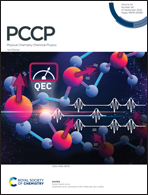Selectivity of volatile organic compounds on the surface of zinc oxide nanosheets for gas sensors
Abstract
The detection of volatile organic compounds by gas sensors is of great interest for environmental quality monitoring and the early-stage and noninvasive diagnosis of diseases. Experiments found hexane, toluene, aniline, butanone, acetone, and propanol gases in the exhaled breath of patients suffering from COVID-19, lung cancer, and diabetes. However, no studies are available to systematically elucidate the selectivity of these gases on nanosheets of zinc oxide for chemiresistive and direct thermoelectric gas sensors. Therefore, this work performed the elucidation by studying the electronic, electrical, and thermal properties of the bilayered ZnO nanosheets with polar (0001) and non-polar (11![[2 with combining macron]](https://www.rsc.org/images/entities/char_0032_0304.gif) 0) surfaces under the adsorption of the gases. The interaction between the gases and the nanosheets belongs to two groups: electrostatic attraction and charge exchange. The second one occurs due to the peak resonance of the same type of orbitals between the substrates and the gases along the surface normal and the first one for the other cases. The characteristics of the Seebeck coefficient exhibited distinct selectivity of butanone and acetone.
0) surfaces under the adsorption of the gases. The interaction between the gases and the nanosheets belongs to two groups: electrostatic attraction and charge exchange. The second one occurs due to the peak resonance of the same type of orbitals between the substrates and the gases along the surface normal and the first one for the other cases. The characteristics of the Seebeck coefficient exhibited distinct selectivity of butanone and acetone.



 Please wait while we load your content...
Please wait while we load your content...